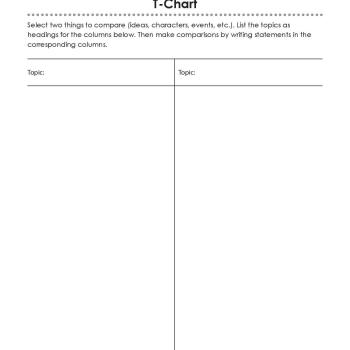Graphic Organizer
T-Chart

Grades
3 - 8
Printout Type
Graphic Organizer
About this printout
Use this T-Chart to examine two facets of an object, situation, or event and to make comparisons related to a variety of subjects and content areas.
Teaching with this printout
Students in grades 3–8 should be able to make comparisons in a variety of contexts. The T-Chart is a handy graphic organizer students can use to compare and contrast ideas in a visual representation. T-Charts can be used in any content area or genre, such as with books or book characters, scientific phenomena, or social studies events. Students will enjoy the easy format in which they can list similarities and differences between two different kinds of events or ideas.
More ideas to try
- Have students use the T-Chart as a tool for making an important class decision. For example, students may want to decide where to go for a class field trip. As a class (or in small groups), ask students to list one of two choices at the top of each column and then list the benefits and/or drawbacks of each one. Once these have been listed, the class can compare the information to make the best decision.
- Have students use the T-Chart to compare issues related to social studies topics. For example, student can compare the views of two political candidates, or they can list the pros and cons of a community switching to geothermal power. Once students have listed issues related to both sides, have students use these ideas in a class debate or for a persuasion essay.
- Use the T-Chart to organize thoughts about a book being read in class. Determine two facets of the story events, such as reality versus fantasy or historic versus fictitious. Guide students in listing each facet at the top of a column. Then, as students read portions of the story, have them list events below the corresponding headings. Follow the activity by engaging students in a discussion about literary genres and the story elements that help to classify the book they are currently reading.